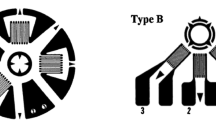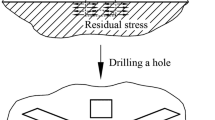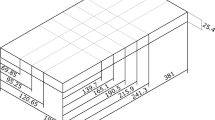Abstract
The residual stress measurement by the Hole-Drilling Method (HDM) is recommended by the ASTM E837.13a for a range of hole diameters and inspection depths. To calculate the stress distribution, calibration coefficients are applied according to the hole diameter and the rosette-type used in the measurement. However, the standard is based on a blind hole which is orthogonal to the specimen surface and with a flat bottom geometry. The commonly used cutting tools in the HDM are end mills, which usually have a chamfer or fillet radius in the corner of the edges. Consequently, chamfers or fillets are directly transferred to the blind hole bottom geometry. This real geometry is not considered by the tabulated calibration coefficients. In order to provide more accuracy to the HDM, this paper provides calibration coefficients determined by FEM simulations according to the real blind hole geometry. Uniform residual stress measurements were made in the A36 steel, AISI304L stainless steel and AA6061 aluminium alloy and evaluated with the coefficients tabulated by the standard and coefficients simulated to the real blind hole geometry. Considerable differences were observed, especially in the first two increments for the measured principal stresses, namely σ1 and σ2.












Similar content being viewed by others
References
ASTM E837.13a (2013) Determining residual stresses by the Hole-Drilling strain gage method. ASTM standard test method E837-13a. American Society for Testing and Materials, West Conshohocken
Nau A, Scholtes B (2013) Evaluation of the high-speed drilling technique for the incremental hole-drilling method. Exp Mech 53(4):531–542. doi:10.1007/s11340-012-9641-1
Blödorn R, Viotti MR, Schroeter RB, Albertazzi AG Jr (2015) Analysis of blind-holes applied in the hole-drilling method for residual stress measurements. Exp Mech 55(9):1745–1756. doi:10.1007/s11340-015-0082-5
Blödorn R, Tamura MT, Henke RA, Viotti MR, Albertazzi Jr. AG, Schroeter RB (2015) Study of the drilling process used in the Hole-Drilling Method through thrust force measurement and tool wear analysis, in 23rd ABCM International Congress of Mechanical Engineering (Rio de Janeiro, 2015), p 1–8. doi:10.20906/CPS/COB-2015-0662
Oettel R (2000) The determination of uncertainties in residual stress measurement. SM&T-UNCERT COP 15
Nau A, von Mirbach D, Scholtes B (2013) Improved calibration coefficients for the hole-drilling method considering the influence of the poisson ratio. Exp Mech 53(8):1371–1381. doi:10.1007/s11340-013-9740-7
Schuster S, Gibmeier J (2016) Incremental hole drilling for residual stress analysis of strongly textured material states – a new calibration approach. Exp Mech 56(3):369–380. doi:10.1007/s11340-015-0104-3
Xiao B, Li K, Rong Y (2009) Numerical study on calibration coefficients for hole-drilling residual stress measurement. Proceedings of the SEM Annual Conference
Scafidi M, Valentini E, Zuccarello B (2011) Error and uncertainty analysis of the residual stresses computed by using the hole drilling method. Strain 47(4):301–312. doi:10.1111/j.1475-1305.2009.00688.x
Scafidi M, Valentini E, Zuccarello B (2009) Effect of the hole-bottom fillet radius on the residual stress analysis by the Hole-Drilling Method. International Centre for Diffraction Data, 263–270. ISSN 1097–0002
Viotti MR, Sutério R, Albertazzi AG Jr, Kaufmann GH (2004) Residual stress measurement using a radial in-plane speckle interferometer and laser annealing: preliminary results. Opt Lasers Eng 42(1):71–84
Viotti MR, Albertazzi Jr. AG (2009) Industrial inspections by speckle interferometry: general requirements and a case study. SPIE Proc 7389, 15p
Viotti MR, Kapp WA, Albertazzi AG Jr (2009) Achromatic digital speckle pattern interferometer with constant radial in-plane sensitivity by using a diffractive optical element. Appl Optics 48(12):2275–2281
Viotti MR, Albertazzi AG Jr, Kapp WA (2008) Experimental comparison between a portable DSPI device with diffractive optical element and a hole drilling strain gage combined system. Opt Lasers Eng 46(11):835–841
Nawwar AM, Shewchuk J (1978) On the measurement of residual-stress gradients in aluminum-alloy specimens. Exp Mech 18(7):269–276
Nelson DV, Makino A, Schmidt T (2006) Residual stress determination using drilling and 3D image correlation. Exp Mech 46(1):31–38. doi:10.1007/s11340-006-5859-0
Callister WD, Rethwisch DG (2010) Materials science and engineering: an introduction. Wiley
Acknowledgments
This research was supported by PETROBRAS through CARD3 project. The authors would like to thank also Centro de Tecnologia e Inovação em Fabricação(CTIF)/UNIFEBE and Laboratório Central de Microscopia Eletrônica (LCME)/UFSC.
Author information
Authors and Affiliations
Corresponding author
Rights and permissions
About this article
Cite this article
Blödorn, R., Bonomo, L.A., Viotti, M.R. et al. Calibration Coefficients Determination Through Fem Simulations for the Hole-Drilling Method Considering the Real Hole Geometry. Exp Tech 41, 37–44 (2017). https://doi.org/10.1007/s40799-016-0152-3
Received:
Accepted:
Published:
Issue Date:
DOI: https://doi.org/10.1007/s40799-016-0152-3




